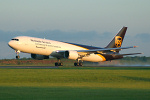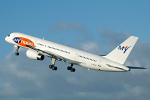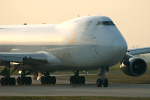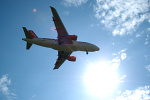Firstly, it goes without saying that a good foundational understanding of the basics of photography will
help anyone interested in taking good aviation photos, and this series of articles will undoubtably touch on few of the basic
terms and topics. However, rather than attempt to document 'shutter speed', 'aperture' or 'depth of field' etc. myself, I'm going to
point you in the direction of another fantastic website which has some excellent illustrations as to how cameras work.
Go and check out Andy Lim's website on Photography Basics.
Digital or Film?
Even just five years ago, you wouldn't have seen many digital cameras around an airport perimeter fence. 35mm print
and slide film has long been the traditional medium for making aviation photos, with many enthusiasts spending a lot of time and money
building up sizeable collections of aviation prints and slides. For some, owning a quality Kodachrome 25 slide was almost as important
as the subject on the film, with many building up personal collections of hundreds of thousands (no joke) of prints and transparencies!
Nowadays, it's very rare to see a 35mm machine around. The digital revolution has well and truly turned photography on its
head, with many aviation enthusiasts now picking up a digital camera and trying their hand at taking photos of aircraft that they would
previously have been happy to watch just roll by.
Some photographers still prefer 35mm cameras, and rightly so. The quality and longevity of a Kodachrome slide will always remain simply
outstanding. But at the same time, it's hard to deny the advantages of digital equipment. After eight years using a film SLR, I
bought my first digital SLR in 2005 and I'm still amazed by the quality of shots that digital cameras produce and the technical flexibility that
they give me. Not to mention the savings that I've made on buying and processing film!
Compact or SLR?
Digital photo technology is still moving forward at a fast pace and the quality of cameras is improving all the
time. Indeed, most of the cameras sitting in shop windows today, both compact and SLR, are capable of producing decent aviation
photos.
Compacts definitely boast simplicity and can be very easy to get to grips with. If you are new to
photography and don't want to break the bank then they are well worth looking into, although remember that the price
tag is generally a good indicator as to what you get for your money.
In terms of functionality and versatility, however, the best compact cameras are no match for even the most basic
Single Lens Reflex cameras, or SLRs as they are known for short. For aviation photographers, the ability to use all sorts of different lenses on
an SLR camera is incredibly useful. For example, photographing an airliner close up on the apron may require a particularly wide angle lens,
whereas capturing an aircraft some distance away on the approach will usually require a lens with some hefty zoom. Whilst a compact camera
with a fixed zoom lens (fixed as in non-interchangeable) might be able to just about cover both scenarios, corners are often cut in the
lens design and manufacturing process to do so. 'Digital zoom' doesn't count, either! With a compact you therefore run the danger of
having what may seem like a capable lens on paper, but when it comes down to it, one which produces relatively poor quality shots –
and no option to change it!
SLR lenses, on the other hand, are designed to leap frog that problem completely, with all the major brands
producing a range of lenses specifically designed to cater for an all-manner of requirements. Using the two scenarios outlined above,
I'd use my 18-55mm lens for photos on the ramp, and then my 70-300mm lens for photographing aircraft on an approach, for example.
Other advantages of SLRs include increased functionality with more control on offer to the user. You can
also be a whole lot more confident that what you see through the viewfinder is exactly what will be recorded on to the sensor. But a big advantage of SLRs
for aviation photographers that that an SLR imposes next to no time delay between pressing the shutter release button and the shutter actually
releasing. Most compacts still suffer from shutter release time lags and these can be very frustrating to work with when taking a photo of a fast moving aircraft!
Put simply, an SLR will help you get better photos, faster.
For more information on what makes a good camera, compact or SLR, see
this article at Ken Rockwell's website - and have a good browse around the rest of the
site while you're there!
What makes a good SLR lens?
It is often said that a camera is only good as the glass on front of it, and that pretty much hits the nail on the head.
So what makes for a good lens?
Sticking with own-brand lenses is a big first step in the right direction. The two big brands, Nikon and Canon, both
produce superb collections of lenses for their SLRs, tailor-made to bring the best out of the same-brand bodies that they're stuck on the
front of. The opposite also very much applies; a Nikon body will definitely bring the best out of a Nikon lens!
However, Nikon and Canon lenses usually come at a cost - the top-end Canon EF-L 400mm f/2.8 lens currently sells for
nearly £7000! An affordable way of acquiring a decent lens is to purchase a Nikon or Canon camera 'kit', whereby an SLR body and lens are
sold in one box and retailed together at a discounted price. Most of the Nikon and Canon amateur and semi-professional bodies are
currently offered with a kit lens (usually in the 18-135mm range) and are worth a good look.
Thankfully, other lens manufactures do exist and also produce excellent products, with Sigma and Tamron being two of
the better brands. Both offer a wide range of lenses for most of the big SLR manufacturers, including Sony, Minolta and Pentax as
well. Their lens specs are usually not far off that of own-brand lenses and are normally available cheaper than their Nikon or Canon
counterparts, too. But their build quality and overall performance can often be less than favorable. I once had
a Sigma lens fall apart in my hands!
The decision between an own-brand or third-party lens can be a difficult one, and it usually comes down to cost.
I personally prefer to use Nikon lenses with my Nikon camera body, but I know plenty of other photographers who get stunning results from their Sigma and Tamron lenses.
Two additional thoughts - firstly, treat 'all in one' lenses (such as a 28-300mm lens) with caution. The beauty of an SLR
camera is that it allows you to use different lenses for different scenarios. However, many photographers seem to forget this and
opt for lenses which claim to cater for both wide angle and high zoom photos, and often for quite a reasonable price.
Beware! Such lenses usually compromise design and build quality with capability and convenience.
If you're considering buying such a lens, do sample it in the store first and keep a good eye out for the suspect signs of
distortion (barreling or bowing), vignetting (dark corners), chromatic aberration (purple/green
fringing) and soft focusing (particularly in corners). Most poorer lenses also suffer from a lack of clarity or contrast.
A good rule of thumb used to be that the ratio of a lens' minimum zoom to
maximum zoom should be no more than 1:3. This is no longer so much the case, with lenses in the 70-300mm and 100-400mm brackets
(~1:4) now common place, but it is well worth remembering that lens quality diminishes as zoom range increases.
Secondly, do look into the recent 'Vibration Reduction' (as coined by Nikon) innovations in lens technology (or
'Image Stabilization', the Canon equivalent). They are two tag-lines for the same thing - essentially the ability to take photos using
low shutter speeds that would traditionally result in evidence of camera shake, particularly at long focal lengths (high zoom) or in
gloomy conditions. I bought my first Vibration Reduction lens earlier this year (a Nikon 70-300mm f/4.5-5.6) and have been blown away
at the photos that I have been able to take; shots that would be have non-starters using my old non-VR equivalent. Again, well worth
considering if they are within your budget!
Coming soon... Part 2: Taking good aviation photos








